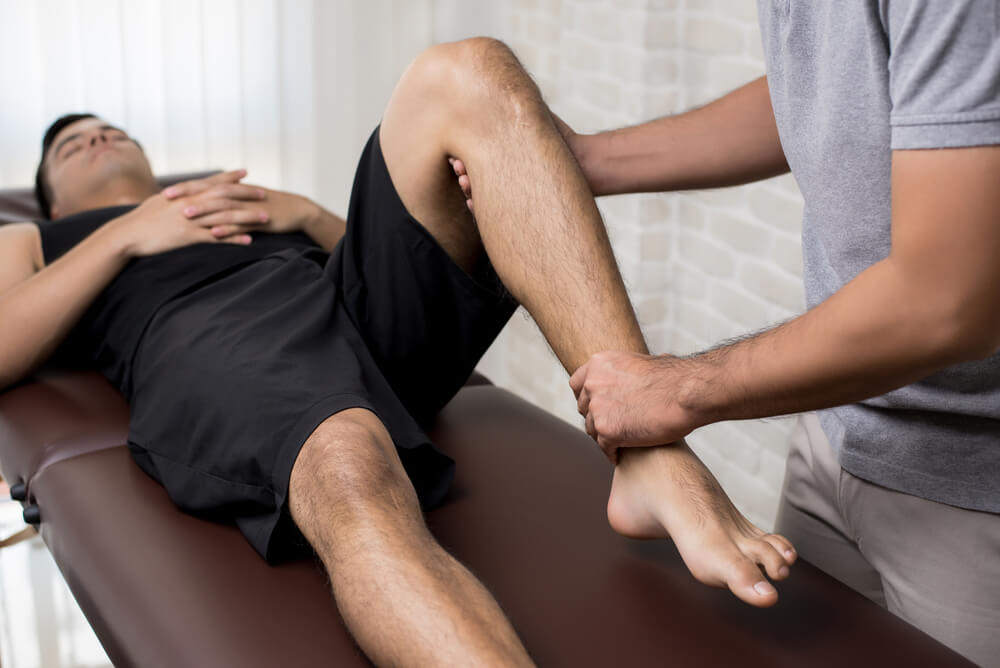For clients coming back from an injury, a combination of massage and physical therapy may be required.
Integrating massage with physical therapy can optimise treatment and fast-track rehabilitation. Both manual therapies work to reduce pain & inflammation and improve mobility and muscle function. Massage can also be a useful add-on to physical therapy as a way to manage the stress that comes with chronic pain or injury.
When combined together, both massage therapy and physical therapy can serve as holistic comprehensive treatment delivering a range of short-term and long-term benefits.
What is physical therapy?
Physical therapy, also known as physiotherapy, restores and promotes muscle and joint health to help clients move better and with less pain.
Physical therapy is carried out by a physical therapist. These allied health professionals use physical manipulation to:
- • Relieve pain
- • Improve mobility and joint function
- • Improve balance and coordination
- • Prevent injury recurrence
- • Manage pain from chronic illnesses such as diabetes, arthritis and heart disease
- • Restore bladder and pelvic health & function
- • Prevent and recover from a sports injury
Apart from manual manipulation, physical therapy treatment may also include supplementary treatments including electrical stimulation for nerve pain and muscular engagement, light therapy, hot & cold therapy and hydrotherapy.
Difference between physical therapy and massage therapy
Both physical therapy and massage therapy are similar in the fact they both use manual manipulation to treat inflammation in the body. However, where massage therapy targets the body’s soft tissues, tendons, muscles and fascia, physical therapy focuses on the entire musculoskeletal system.
Another point of difference between physical therapy and massage therapy is that the former is typically used for specific conditions that require rehabilitation. While massage therapy can also be used to help treat an injury, it is favoured as a type of maintenance therapy that can be used alongside physical therapy for optimum results.
The benefits and importance of massage therapy included in physical therapy
Improve flexibility and range of motion
How flexible you are will depend on the ability of your soft tissues (the muscles, tendons and connective tissues). If these areas are tight or inflamed, then you may have difficulty bending down, reaching for things, throwing a ball or getting a full range of motion when weightlifting.
Flexibility and range of motion go hand in hand. Typically, poor joint function or injury in the muscles supporting the joint can prohibit mobility.
Physical therapy and massage therapy can be used together to boost flexibility by stretching and relaxing the muscle fibres.
Improve posture
Massage can do a lot for your posture as it helps bring your body back to its proper alignment. Modern lifestyle habits such as texting, working at a computer or sitting for prolonged periods can lead to muscles that are either overworked or weak. This can result in poor posture, demonstrating as:
- • Slouched, hunched shoulders
- • Swayback
- • Head tipped forward
- • Pelvic tilt
Poor posture can result in a number of health issues including headaches, neck, shoulder and back pain, and an unsteady gait when walking or running. Both massage therapy and physical therapy can be used to manipulate hyperactive or underworked muscles to get the body back into alignment.
Reduce scar tissue
When you’re injured, the body forms scar tissue around the injury. These adhesions can cause pain, restricted movement and a feeling of prolonged tightness, itching or swelling. If not treated, injury recurrence may occur, which can delay recovery for a very long time.
Both a massage therapist and a physical therapist can target and break up adhesions using different tools and techniques. With regular treatment, scar tissue can clear up resulting in greater mobility and reduced pain.
Improve circulation
The better your circulation, the better your muscles will recover. That’s because healthy circulation delivers oxygen and nutrients to the muscles to help with stiffness and tension.
A combination of massage therapy and physical therapy will improve circulation considerably. Massage helps to move blood through congested areas giving them the oxygen-rich blood they need to heal.
Muscle relaxation
One of the greatest benefits of massage therapy is muscle relaxation. To an athlete or someone recovering from injury, this can be advantageous to their physical and mental recovery.
Suffering from constant muscle pain and tension whether through exercise or an injury can be detrimental to a person’s physical and mental health. Muscle relaxation through massage can support physical therapy treatment by helping these overworked muscles to switch off and relax.
Massage therapy techniques to include
Trigger point release
Massage therapists can use trigger point therapy to release painful tension and knots in the muscles and fascia.
This form of myofascial release can help to properly align the fascia surrounding the muscles, bringing relief to tight and sore trigger points in the body. Trigger point release can be applied in areas such as the elbow, pelvic floor, shoulder and lower back.
Massage therapists will use their thumb, elbow, palm or a prop to target these trigger points by applying pressure to them.
Soft tissue massage
The soft tissues include all muscles, tendons, skin and fibrous tissue in the body. Soft tissue massage, therefore, works at restoring flexibility and looseness to tight, stretched, overworked muscles.
Soft tissue massage involves a range of depths, pressures and durations to achieve this, and is helpful in those presenting with muscle soreness, headaches, tennis elbow, plantar fasciitis, tension, poor posture and arthritis.
Active release technique
Massage therapists may apply active release technique (ART) to help break up scar tissue and inflammation in the body.
Active release is helpful in treating a range of soft tissue injuries along with referred pain from these injuries. Much like deep tissue massage, ART can be used to treat pain and other symptoms caused by soft tissue injuries.
Myofascial release
Myofascial release is a manual massage technique to relieve fascia tension.
The fascia is the layer of tissue connecting the spine and muscles. When fascia is tense, in cases like myofascial pain syndrome, muscles can be restricted, restricting movement and chronic pain can occur as a result.
Myofascial release works by applying gentle, prolonged pressure on the sore muscles. Manual pressure and manipulation are applied to stretch any ridged areas until the tension is fully released.
While many people will benefit from a standalone massage or physical therapy treatment regime, combining both treatments can help them to recover better and faster.
Massage therapy combined with physical therapy will ensure client’s are getting access to a whole host of techniques and treatments to regain strength, relieve pain and gain more functional movement.
Discover Massage Australia provides industry-recognised courses covering vital massage techniques so that you can help clients fast track their physical therapy and recovery.

